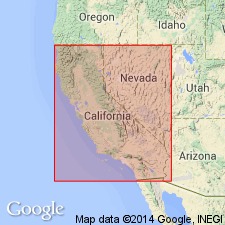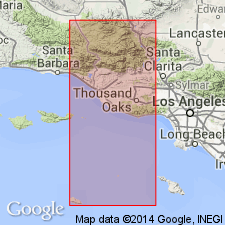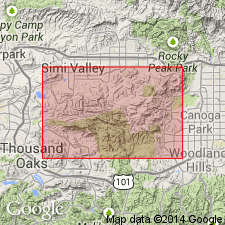
- Usage in publication:
-
- Las Virgenes sandstone
- Modifications:
-
- Named
- Biostratigraphic dating
- Dominant lithology:
-
- Sandstone
- Shale
- AAPG geologic province:
-
- Ventura basin
Summary:
Named as middle unit (of 3) of Martinez group for typical development at Las Virgenes Canyon on south side of Simi Hills, Ventura Co, CA. Measured section, 311 feet thick, is located 1 mi west of head of Las Virgenes Canyon. Consists of coarse-grained arkosic, feldspathic, and micaceous sandstone beds with some interbedded soft, light chocolate-brown shales. Overlies with gradational contact Simi conglomerate (new); grades upward into Martinez marine member (new) (both of Martinez group). Contains pelecypods (CRASSATELLITES BRANNERI Waring) in western part. Age of Martinez group given as early Eocene based on megafossils south of Simi Valley, Ventura Co.
Source: GNU records (USGS DDS-6; Menlo GNULEX).

- Usage in publication:
-
- Las Virgenes Sandstone
- Modifications:
-
- Age modified
- AAPG geologic province:
-
- Ventura basin
Summary:
West of Runkle Canyon, medium- to very coarse-grained, poorly sorted, micaceous, light-gray to white sandstone is considered Las Virgenes Sandstone. East of Runkle Canyon sandstone grades into Simi Conglomerate and can no longer be separated from it. Upper part of Las Virgenes Sandstone and Simi Conglomerate contain IN-SITU brackish water megafossils as described by Fantossi (1955, MA thesis) and Zinsmeister (personal commun., 1973). Age is given as Paleocene.
Source: GNU records (USGS DDS-6; Menlo GNULEX).

- Usage in publication:
-
- Las Virgenes Sandstone
- Modifications:
-
- Not used
- AAPG geologic province:
-
- Ventura basin
Summary:
Las Virgenes Sandstone consists of coarsely cross-bedded near-shore to beach sandstone and carbonaceous silty sandstones. Gradational contact with underlying Simi Conglomerate together with eastward thinning of Las Virgenes Sandstone suggest that Las Virgenes Sandstone represents fine-grained facies of Simi Conglomerate.
Source: GNU records (USGS DDS-6; Menlo GNULEX).
For more information, please contact Nancy Stamm, Geologic Names Committee Secretary.
Asterisk (*) indicates published by U.S. Geological Survey authors.
"No current usage" (†) implies that a name has been abandoned or has fallen into disuse. Former usage and, if known, replacement name given in parentheses ( ).
Slash (/) indicates name conflicts with nomenclatural guidelines (CSN, 1933; ACSN, 1961, 1970; NACSN, 1983, 2005, 2021). May be explained within brackets ([ ]).

